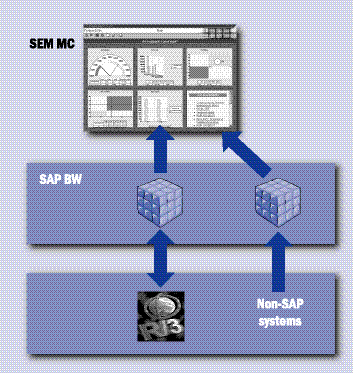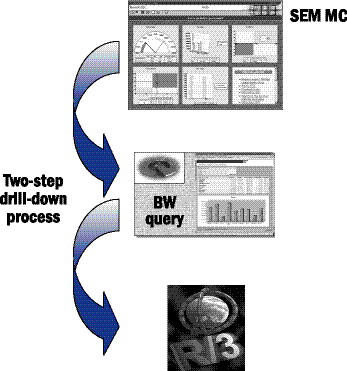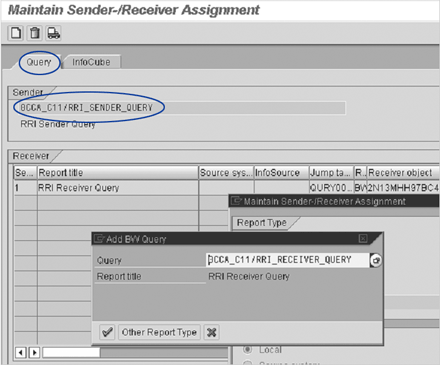SEM's Management Cockpit (MC) creates easy-to-use graphics that display data of all types. While most executives want to see the summarized data that the cockpit displays so well, they also want to be able to examine the details of that data. The author explains how to use a little known piece of functionality that allows a user to drill down from an MC graph to a BW query. From there, the user then can drill down further into an R/3 line item report.
SEM’s Management Cockpit (MC) is often thought of as a reporting solution for the masses. It creates easy-to-use graphics that display data of all types. However, I hear the same questions over and over again from users: “Can’t I do this in BW?” and “what kind and level of detail should I put into the cockpit?” This article will answer those questions by telling you what the cockpit is, zhow it interacts with Business Information Warehouse (BW), and how to implement a little-known piece of MC functionality to give users the flexibility they so often need.
The Management Cockpit is just one piece of functionality within Strategic Enterprise Management’s Performance Measurement (SEM-PM) component. (See
Figure 1.)

Figure 1
SEM’s five components
The cockpit can be best compared to what is known as a digital dashboard. (See
Figure 2.) It displays data graphically on a computer screen, giving the computer’s user an alternative to viewing the data in the standard tabular format found in BW. The cockpit has the same types of graphs that you find in Microsoft Excel such as line graphs, column graphs, and tachometers. As with all of SEM’s components, the cockpit is installed on SAP’s BW. This means that BW acts as the cockpit’s database, with the cockpit displaying data stored in BW. (See
Figure 3.)

Figure 2
SEM’s Management Cockpi

Figure 3
How the Management Cockpit is populated with data
What differentiates SEM’s MC from both BW and R/3 reports is that the MC was designed with the reporting needs of an executive in mind. Navigation is achieved with a simple point and click, measure statuses are displayed using red, yellow, and green icons, and data is best viewed at a summarized level. Cockpits are configured in a hierarchical fashion, giving users access to high-quality graphs that support business decisions.
Because the cockpit can display any BW data regardless of its functional area or the level of detail where it is stored, some confusion exists among project managers when they are preparing for a cockpit implementation. The confusion results from the redundancy between what can be achieved with a cockpit project and what can be delivered via a simple BW query. For example, while most mid-level managers want line item detail in their reports and the ability to “slice and dice” the data, MC is best at displaying summarized BW data without slice-and-dice capabilities.
While most executives want to see the summarized data that the cockpit displays so well, they also want to be able to drill down into the details of that data (which the cockpit doesn’t allow for). So neither BW with its line item or summarized tabular reports, nor the MC with its graphic summarized data, is a perfect option on its own. However, when configured using a little known piece of functionality, a user can “drill down” from an MC graph to a BW query. From there, the user then can drill down further into an R/3 line item report. (See
Figure 4.)

Figure 4
Process of drilling down from the Management Cockpit to a BW query to an R/3 report
When the cockpit is configured this way, executives can get both the summarized graphics and the line item detail they want. Managers who want only line item detail should continue using either R/3 reports or line item BW reports.
Configuring for Drill-Down
To achieve the functionality needed for this line item drill-down from the MC, you need to perform configuration in both BW and SEM (and possibly R/3 if your desired line item report hasn’t already been created there). In addition, line item data must exist in R/3 to achieve true line item drill-down. In the following steps, I’ll show you how to configure the necessary pieces in both BW and SEM. When detailing these steps, I’m assuming that you have a completely configured MC (with at least one frame), an existing BW query (using Business Explorer [BEx] Analyzer), and a line item report in R/3. These three items must exist before the following steps can be configured, because they connect to each other.
Step 1. Connect MC graph to BW Query
The full configuration of an MC graph, also called a frame, requires nine steps. The seventh step in that process,
Reports and Links (
Figure 5), allows you to assign various types of reports to a frame, including the following: BW BEx Analyzer reports, Web reports (built with either the Web Application Server or those accessible via an Internet Transaction Server), BW workbooks, or any other Internet URL. To assign reports, follow this process:
- In the SEM system, navigate to the design area of the MC frame for which you want to configure drilldown and click on step seven, Reports and Links.
- In the right frame, click on the Queries button.
- If the query you want to drill to from the frame is on the same BW server as the MC, choose Local in the resulting pop-up window. If it is on a different server, choose Remote and select the appropriate remote function call location where the query resides.
- Select the query to be attached (multiple queries can be attached, but these steps need to be repeated for each query/report/URL).
- Click on the Continue button to advance to step eight.
- Click on the Continue button to advance to step nine.
- Click on the save icon.

Figure 5
Configuring drill-down from an MC frame to a BW query
Step 2. Connect BW Query to R/3 Line Item Report
Next, go to the main BW navigation page in the BW system where the query you assigned in step 1 resides (
Figure 6) and follow this process:
- Follow the menu path Business Explorer>Query>Targets.
- Select the Query tab. Enter the technical name of the query (if you happen to know it) or put your cursor on the blank field, press F4, and select the technical name of the desired query from the drop-down list. If the query selection list is blank, press the Infoareas button at the top of the pop-up window.
- Click on the create icon.
- In the top half of the Maintain Sender-/Receiver Assignment pop-up window, select ABAP report. In the bottom half, select Source system. In the empty field to the right, choose the R/3 system where your R/3 line item detail report resides.
- Finally, enter the technical name of the R/3 line item report in the Report field.
- Click on the Transfer button.
- Click on the save icon.

Figure 6
Configuring drill-down from a BW query to an R/3 report
After you configure these two steps for each MC graph and BW query that your users will want to drill down into, you can observe the use of this functionality by opening up the cockpit application. After navigating to a frame where you assigned a BW query, you see a button on the right side of the toolbar labeled
Reports and Links. (See
Figure 7.) Click on this button and select the BW query you previously assigned to this frame in step 1.

Figure 7
Management Cockpit frame
After the BW query appears on your desktop, select a cell within the query to drill into the R/3 report. Then, right-click on the cell and select Goto along with the R/3 report you previously assigned in step 2. (See
Figure 8.) This selection causes the R/3 line item report, your final destination, to appear.

Figure 8
Drill-down from a BW query to an R/3 repor
Final Recommendations
It takes some planning to determine the optimal BW queries and R/3 reports to link to certain MC graphs. For example, a summarized MC sales graph should have a more detailed (but not line item granularity) BW query assigned to it. This way a user can, for example, look at a corporate-wide sales revenue graph and drill into a BW query that lists sales revenues by region and by product. A deeper drill-down into R/3 would take the user into specific sales line items that cannot be seen in BW/SEM.
While this example is fitting for a sales graph in the cockpit, an asset allocation graph would require completely different BW/R/3 report assignments. Before beginning your MC and BW drilldown configuration, first decide which cockpit graphs require this configured drilldown. Once you know which graphs require drill-down, you will be able to determine which BW/R/3 reports should be assigned.
Paul Halley
Paul Halley is director of Strategic Enterprise Management (SEM) for Business Information Solutions, LLC (BIS). Prior to joining BIS, Paul was SAP America's and SAP Public Sector's leading expert on SEM. As the SEM product manager and lead solutions engineer, Paul was responsible for some of the first US SEM implementations and the subsequent rollout of SEM throughout North and South America. He has a BA degree in economics from Illinois Wesleyan University and an MBA from the Owen School of Management at Vanderbilt University.
You may contact the author at
paul.halley@bisamerica.com.
If you have comments about this article or publication, or would like to submit an article idea, please contact the
editor.
















